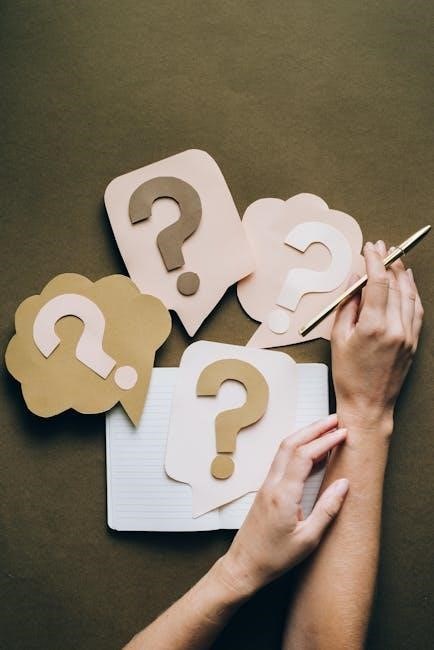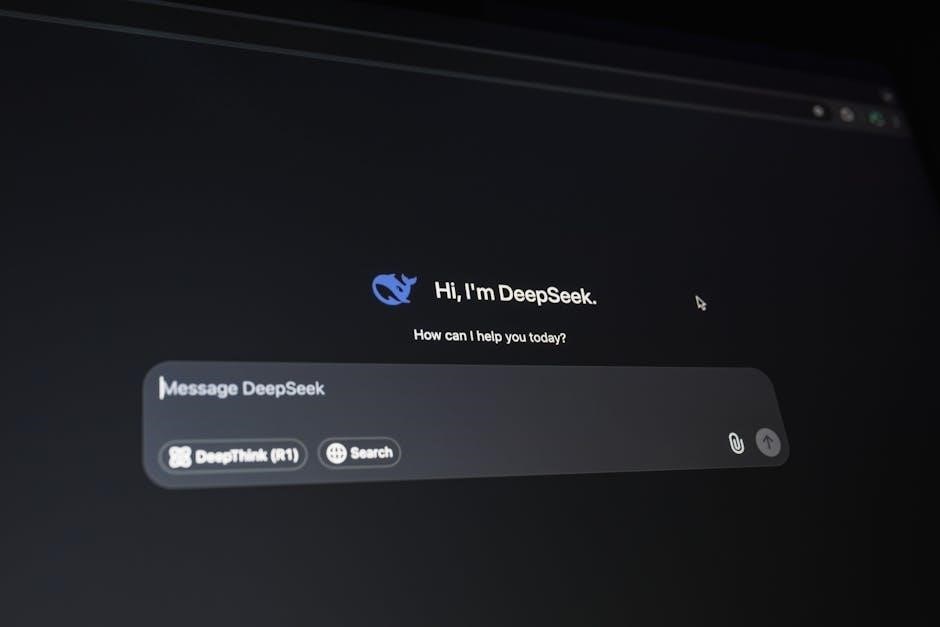Guiding questions are open-ended inquiries designed to spark critical thinking and exploration. They help structure learning, research, or problem-solving processes, ensuring focused and meaningful outcomes in educational and professional contexts.

1.1 Definition of a Guiding Question
A guiding question is an open-ended inquiry designed to direct exploration, critical thinking, and problem-solving. It is a foundational tool used in education, research, and professional contexts to focus investigations and stimulate deeper understanding. Unlike yes/no questions, guiding questions require detailed answers and often encourage multiple perspectives. They are typically specific enough to provide direction but broad enough to allow for comprehensive analysis. For example, “How does climate change impact biodiversity?” or “What are the causes of homelessness?” These questions are crafted to provoke thought, challenge assumptions, and guide learners or researchers toward meaningful insights and solutions. They are essential for structuring inquiries, fostering creativity, and ensuring that the exploration process remains purposeful and aligned with desired outcomes.
1.2 Importance of Guiding Questions
Guiding questions play a crucial role in fostering critical thinking, focus, and purposeful exploration. They help learners and researchers stay aligned with their objectives while encouraging deeper understanding and meaningful insights. By framing inquiries in a structured yet open-ended manner, guiding questions promote engagement, creativity, and analytical skills. They are particularly valuable in educational settings, where they help students develop a systematic approach to problem-solving and encourage active learning. In professional contexts, guiding questions can enhance decision-making processes and ensure that investigations remain relevant and effective. Ultimately, guiding questions serve as a foundation for inquiry-based learning, enabling individuals to navigate complex topics with clarity and purpose. Their ability to spark curiosity and direct exploration makes them an indispensable tool in both academic and professional environments.

How to Create Effective Guiding Questions
To create effective guiding questions, start with clear and focused queries, incorporating the 5 Ws (Who, What, When, Where, Why) and How. Ensure they are open-ended to encourage exploration and critical thinking.
2.1 Using Journalistic Questions (5 Ws and H)
Journalistic questions, known as the 5 Ws and H, are essential for crafting effective guiding questions. These include Who, What, When, Where, Why, and How. By incorporating these elements, questions become comprehensive and targeted, ensuring all aspects of a topic are explored. For instance, asking “Who is involved?” clarifies stakeholders, while “What is the main issue?” defines the problem. “When” and “Where” provide context, “Why” explores motivations, and “How” explains methods. This approach helps in creating well-rounded inquiries that guide deeper investigation and understanding. It is particularly useful in educational settings to encourage students to think critically and cover all dimensions of a subject. Using these questions ensures that guiding queries are thorough and lead to meaningful insights.

Google Search Tips for Refining Your Query
Use OR to broaden searches, AND to narrow results, intitle for specific page titles, and exclude terms to refine queries, ensuring precise and relevant search outcomes quickly.

3.1 Using OR to Broaden Search
Using “OR” in Google searches allows you to broaden your query by including results that contain either of the specified terms. This is particularly useful when searching for synonyms or related concepts, such as “education OR schooling,” which retrieves results containing either term. By incorporating “OR,” you can cast a wider net and explore a broader range of topics, making your search more comprehensive. This technique is especially helpful when you’re unsure of the exact terminology or want to discover alternative perspectives. For instance, searching “climate change OR global warming” will yield results that mention either phrase, providing a more extensive overview of the topic. This approach ensures you don’t miss relevant information by limiting your search to a single term, thereby enhancing the depth and variety of your findings.
3.2 Using AND to Narrow Search

Using “AND” in Google searches helps narrow down results by requiring both specified terms to be present. This operator is essential for refining queries to focus on specific topics. For example, searching “education AND technology” will only show results that include both terms, ensuring relevance. To further enhance precision, combine “AND” with other techniques. For instance, using quotes for exact phrases, like “education AND ‘artificial intelligence,'” yields more targeted outcomes. Additionally, you can pair “AND” with “OR” to refine complex queries, such as “education AND (technology OR innovation).” This approach is particularly useful for academic or professional research, where narrowing down to the most relevant information is crucial. By strategically using “AND,” you can eliminate irrelevant results and focus on content that directly addresses your query, making your search more efficient and effective. This technique is especially valuable when exploring specific aspects of a broader topic.
3.3 Using intitle for Specific Results
The “intitle” operator is a powerful tool for refining Google searches by targeting specific terms in webpage titles. This technique ensures that your results are highly relevant to your query, as it focuses only on pages where the specified keywords appear in the title. For example, searching “intitle:marketing intitle:inbound” will yield results with both “marketing” and “inbound” in their titles, providing precise and focused outcomes. This is especially useful when looking for authoritative sources or specific types of content. By combining “intitle” with other operators like “OR” or “AND,” you can further tailor your search. For instance, “intitle:guiding questions OR intitle:critical thinking” will retrieve pages with either phrase in the title, enhancing the breadth of your results while maintaining specificity. Using “intitle” effectively streamlines your research process, ensuring that you quickly find the most relevant and accurate information available online. This method is particularly beneficial for academic or professional searches, where time efficiency and precision are paramount. By leveraging the “intitle” operator, you can significantly improve the quality and relevance of your search results, making your research more effective and productive.
3.4 Excluding Terms from Search
Excluding specific terms from your search can help refine results and eliminate irrelevant information. In Google, this is achieved by using a minus sign (-) before the term you wish to exclude. For example, searching “guiding questions -education” will yield results about guiding questions that do not mention education. This technique is particularly useful when certain words have multiple meanings or when you want to avoid unrelated topics. By excluding specific terms, you can focus your search on the most relevant content. For instance, if you’re researching “guiding questions” but want to avoid articles related to “critical thinking,” you can search “guiding questions -critical thinking.” This ensures your results are more targeted and aligned with your specific needs. Regularly using this operator can significantly enhance the efficiency of your research and help you find exactly what you’re looking for without sifting through unnecessary information. This method is especially handy for academic or professional searches where precision is key.

Role of Guiding Questions in Education
Guiding questions play a vital role in education by fostering engagement and deeper understanding. They encourage students to explore topics thoroughly, promoting meaningful learning experiences.

4.1 Promoting Critical Thinking

Guiding questions are instrumental in fostering critical thinking by encouraging students to analyze, evaluate, and synthesize information. They prompt learners to explore multiple perspectives, question assumptions, and seek evidence-based answers. For instance, a question like “What are the causes of homelessness?” compels students to investigate various factors, such as economic conditions, social policies, and personal circumstances, rather than settling for a simplistic explanation. This approach cultivates deeper understanding and the ability to address complex issues. By framing inquiries that require analysis, guiding questions help students develop the skills to evaluate information, identify patterns, and form well-supported conclusions. This process not only enhances problem-solving abilities but also prepares students to navigate real-world challenges with a critical and inquisitive mindset.
4.2 Application Across Educational Stages
Guiding questions are versatile tools applicable across all educational stages, from elementary to higher education. At the elementary level, they help students develop foundational skills by encouraging curiosity and exploration. For example, questions like “What causes day and night?” simplify complex concepts for young learners. In middle school, guiding questions become more detailed, fostering deeper understanding, such as “How does photosynthesis affect our environment?” At the high school level, they often align with subject-specific inquiry, like “How does Shakespeare’s context influence his writing?” In higher education, guiding questions are used to frame research and critical analysis, such as “What are the implications of climate change on global economies?” This progression ensures that students at every stage develop the ability to think critically and approach problems systematically, preparing them for lifelong learning and intellectual growth.
